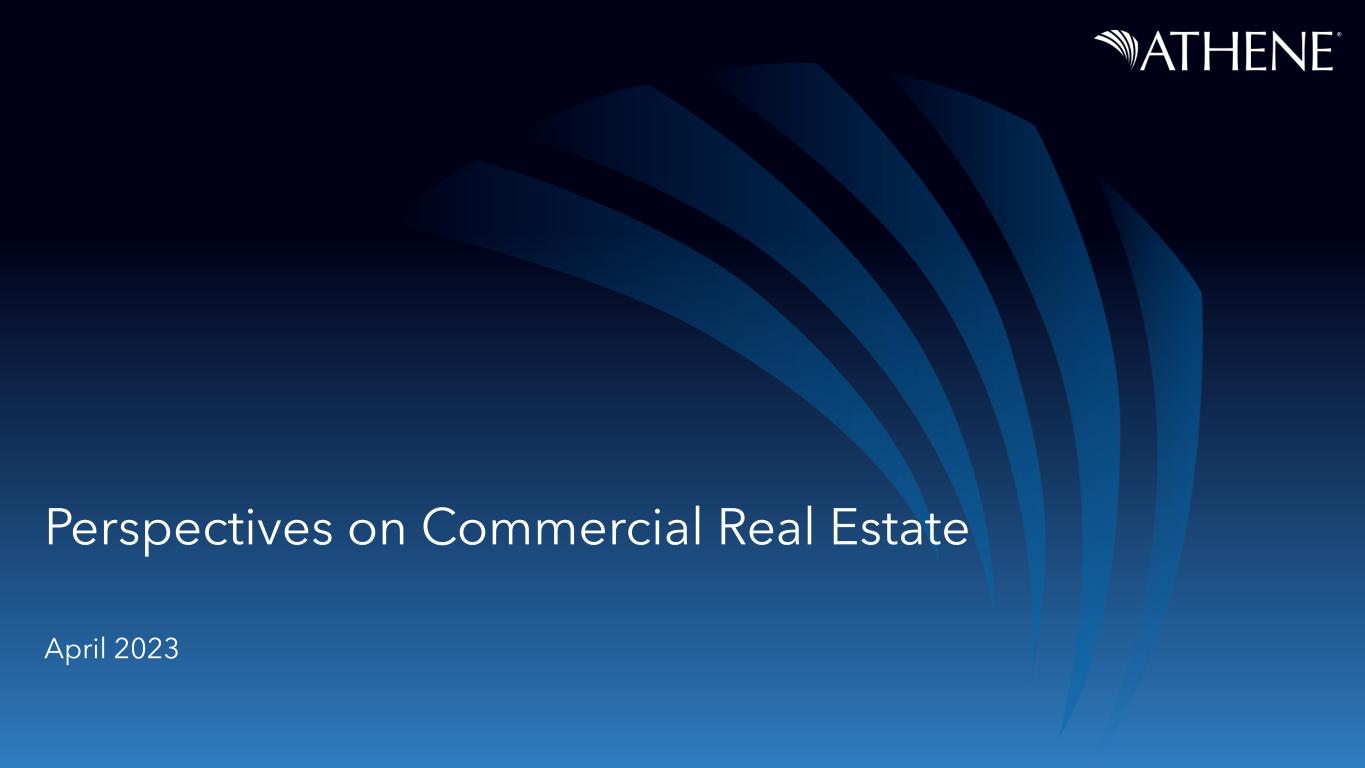
Perspectives on Commercial Real Estate April 2023
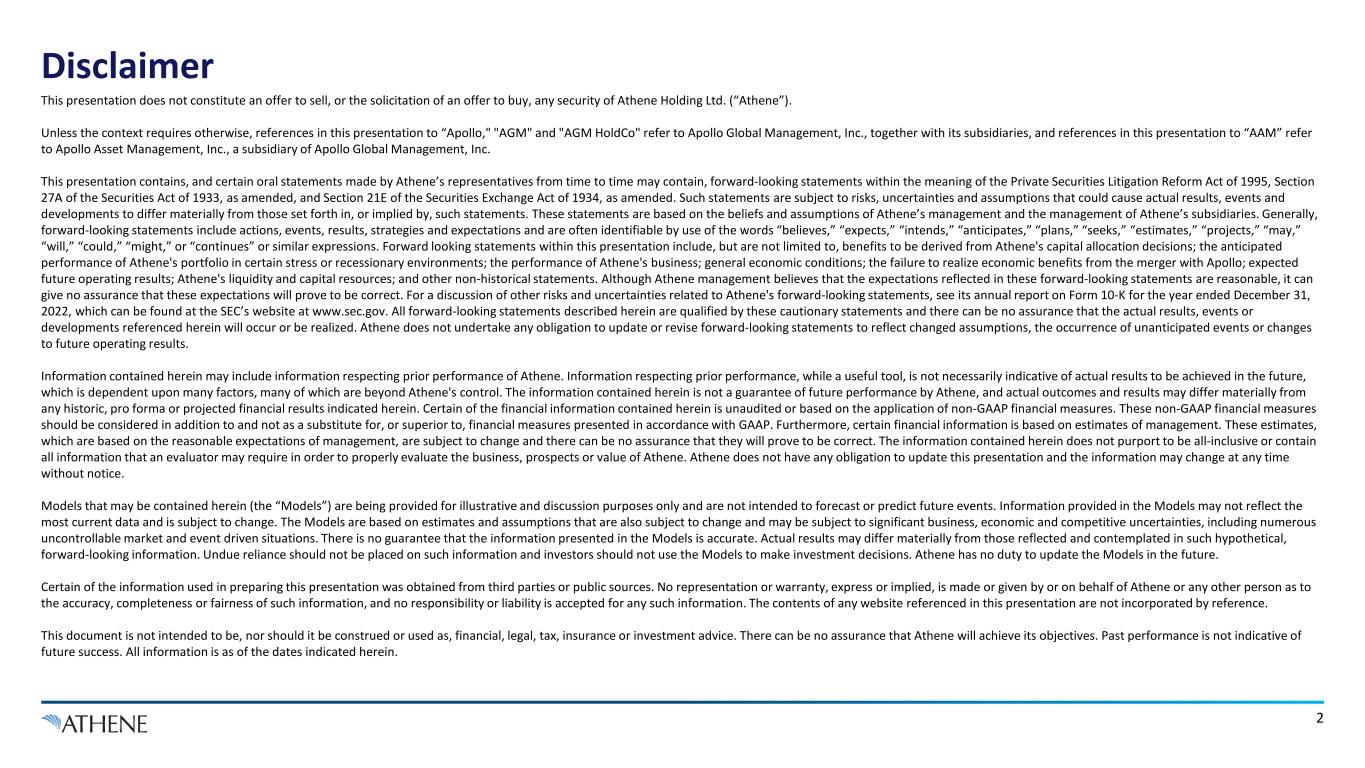
Disclaimer This presentation does not constitute an offer to sell, or the solicitation of an offer to buy, any security of Athene Holding Ltd. (“Athene”). Unless the context requires otherwise, references in this presentation to “Apollo," "AGM" and "AGM HoldCo" refer to Apollo Global Management, Inc., together with its subsidiaries, and references in this presentation to “AAM” refer to Apollo Asset Management, Inc., a subsidiary of Apollo Global Management, Inc. This presentation contains, and certain oral statements made by Athene’s representatives from time to time may contain, forward-looking statements within the meaning of the Private Securities Litigation Reform Act of 1995, Section 27A of the Securities Act of 1933, as amended, and Section 21E of the Securities Exchange Act of 1934, as amended. Such statements are subject to risks, uncertainties and assumptions that could cause actual results, events and developments to differ materially from those set forth in, or implied by, such statements. These statements are based on the beliefs and assumptions of Athene’s management and the management of Athene’s subsidiaries. Generally, forward-looking statements include actions, events, results, strategies and expectations and are often identifiable by use of the words “believes,” “expects,” “intends,” “anticipates,” “plans,” “seeks,” “estimates,” “projects,” “may,” “will,” “could,” “might,” or “continues” or similar expressions. Forward looking statements within this presentation include, but are not limited to, benefits to be derived from Athene's capital allocation decisions; the anticipated performance of Athene's portfolio in certain stress or recessionary environments; the performance of Athene's business; general economic conditions; the failure to realize economic benefits from the merger with Apollo; expected future operating results; Athene's liquidity and capital resources; and other non-historical statements. Although Athene management believes that the expectations reflected in these forward-looking statements are reasonable, it can give no assurance that these expectations will prove to be correct. For a discussion of other risks and uncertainties related to Athene's forward-looking statements, see its annual report on Form 10-K for the year ended December 31, 2022, which can be found at the SEC’s website at www.sec.gov. All forward-looking statements described herein are qualified by these cautionary statements and there can be no assurance that the actual results, events or developments referenced herein will occur or be realized. Athene does not undertake any obligation to update or revise forward-looking statements to reflect changed assumptions, the occurrence of unanticipated events or changes to future operating results. Information contained herein may include information respecting prior performance of Athene. Information respecting prior performance, while a useful tool, is not necessarily indicative of actual results to be achieved in the future, which is dependent upon many factors, many of which are beyond Athene's control. The information contained herein is not a guarantee of future performance by Athene, and actual outcomes and results may differ materially from any historic, pro forma or projected financial results indicated herein. Certain of the financial information contained herein is unaudited or based on the application of non-GAAP financial measures. These non-GAAP financial measures should be considered in addition to and not as a substitute for, or superior to, financial measures presented in accordance with GAAP. Furthermore, certain financial information is based on estimates of management. These estimates, which are based on the reasonable expectations of management, are subject to change and there can be no assurance that they will prove to be correct. The information contained herein does not purport to be all-inclusive or contain all information that an evaluator may require in order to properly evaluate the business, prospects or value of Athene. Athene does not have any obligation to update this presentation and the information may change at any time without notice. Models that may be contained herein (the “Models”) are being provided for illustrative and discussion purposes only and are not intended to forecast or predict future events. Information provided in the Models may not reflect the most current data and is subject to change. The Models are based on estimates and assumptions that are also subject to change and may be subject to significant business, economic and competitive uncertainties, including numerous uncontrollable market and event driven situations. There is no guarantee that the information presented in the Models is accurate. Actual results may differ materially from those reflected and contemplated in such hypothetical, forward-looking information. Undue reliance should not be placed on such information and investors should not use the Models to make investment decisions. Athene has no duty to update the Models in the future. Certain of the information used in preparing this presentation was obtained from third parties or public sources. No representation or warranty, express or implied, is made or given by or on behalf of Athene or any other person as to the accuracy, completeness or fairness of such information, and no responsibility or liability is accepted for any such information. The contents of any website referenced in this presentation are not incorporated by reference. This document is not intended to be, nor should it be construed or used as, financial, legal, tax, insurance or investment advice. There can be no assurance that Athene will achieve its objectives. Past performance is not indicative of future success. All information is as of the dates indicated herein. 2

Industry Considerations
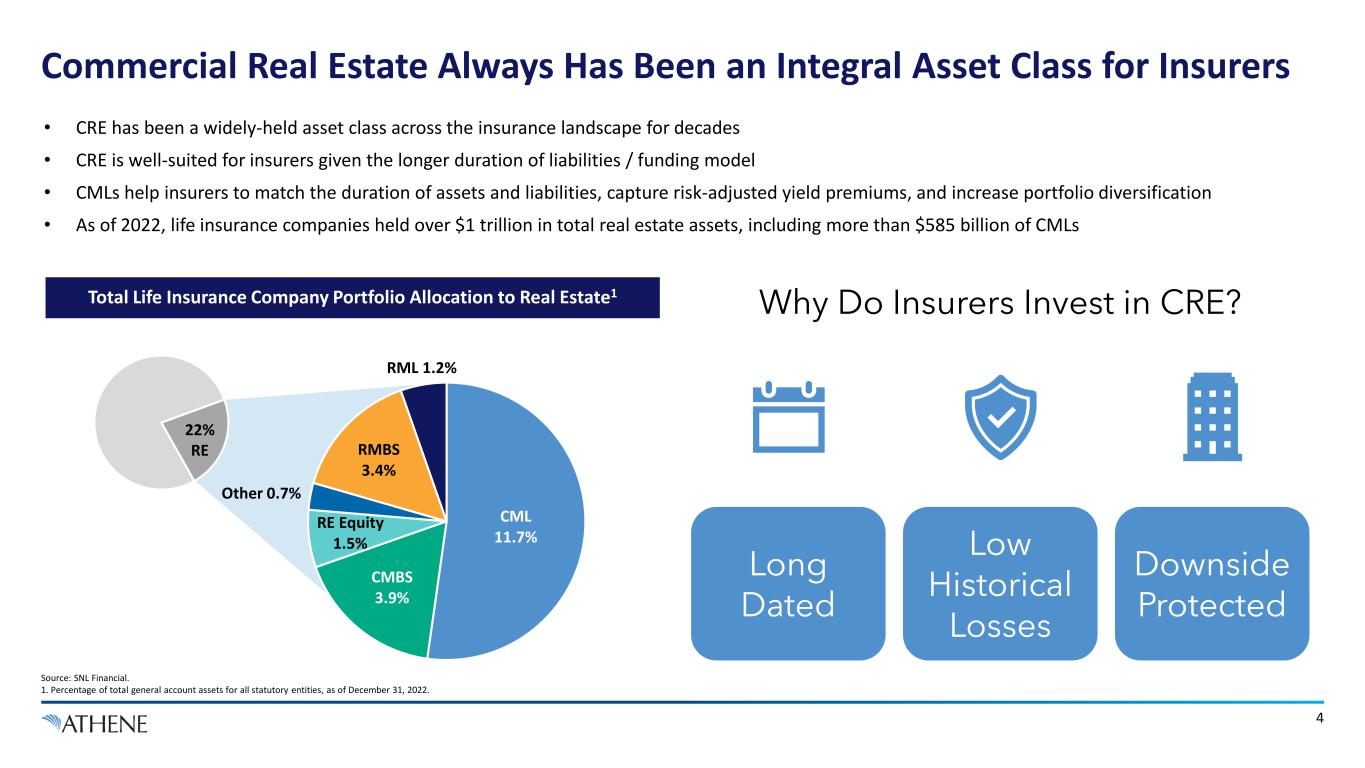
Commercial Real Estate Always Has Been an Integral Asset Class for Insurers Source: SNL Financial. 1. Percentage of total general account assets for all statutory entities, as of December 31, 2022. 4 • CRE has been a widely-held asset class across the insurance landscape for decades • CRE is well-suited for insurers given the longer duration of liabilities / funding model • CMLs help insurers to match the duration of assets and liabilities, capture risk-adjusted yield premiums, and increase portfolio diversification • As of 2022, life insurance companies held over $1 trillion in total real estate assets, including more than $585 billion of CMLs Long Dated Low Historical Losses Downside Protected Total Life Insurance Company Portfolio Allocation to Real Estate1 22% RE Why Do Insurers Invest in CRE? CML 11.7% CMBS 3.9% RE Equity 1.5% Other 0.7% RMBS 3.4% RML 1.2%

Capital Requirements and Return Potential Drive Behavior 1. Refers to NAIC required capital levels at an illustrative 100% Risk-Based Capital (RBC) level. 2. Commercial Mortgage Loans assume CM2 under NAIC. 3. Commercial real estate equity assumes Schedule A direct real estate at low LTVs. 5 • The National Association of Insurance Commissioners’ (NAIC) capital requirements for commercial real estate vary based on fundamental metrics (e.g. loan-to-value and debt service coverage ratio) and idiosyncratic features • The NAIC’s calculation of capital requirements are “procyclical” as they are based on backward looking metrics • For example, the NAIC calculates debt service coverage ratios using 3-year trailing income earned on the properties • This results in capital requirements that are lowest at the peak of the market, just before heading into a downturn • In 2021, the NAIC lowered capital charges on Schedule A Real Estate Equity from 15% to 11% and Schedule BA Real Estate Equity from 23% to 13% Select Asset Class Illustrative Return Profile NAIC Capital Requirement1 Single ‘A’ Corporate Debt ~5% ~1% Single ‘A’ Structured Credit ~6-7% ~1% Commercial Mortgage Loans2 ~5-7% ~2% Commercial Real Estate Equity3 ~10% ~11-13% Equities / Alternatives ~11-12% ~30-40% Context on CRE Capital Requirements
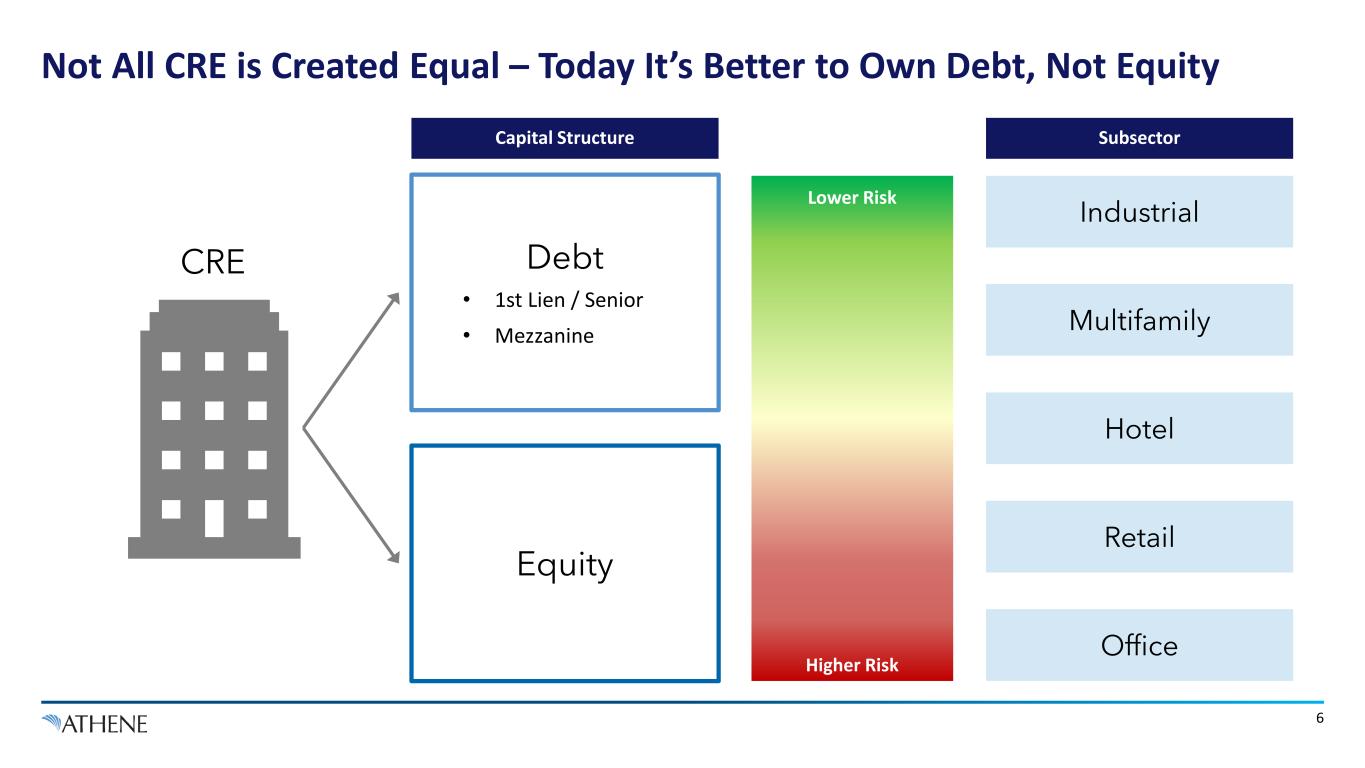
Not All CRE is Created Equal – Today It’s Better to Own Debt, Not Equity 6 Debt • 1st Lien / Senior • Mezzanine Equity Higher Risk Lower Risk Capital Structure Subsector Industrial Multifamily Hotel Retail Office CRE
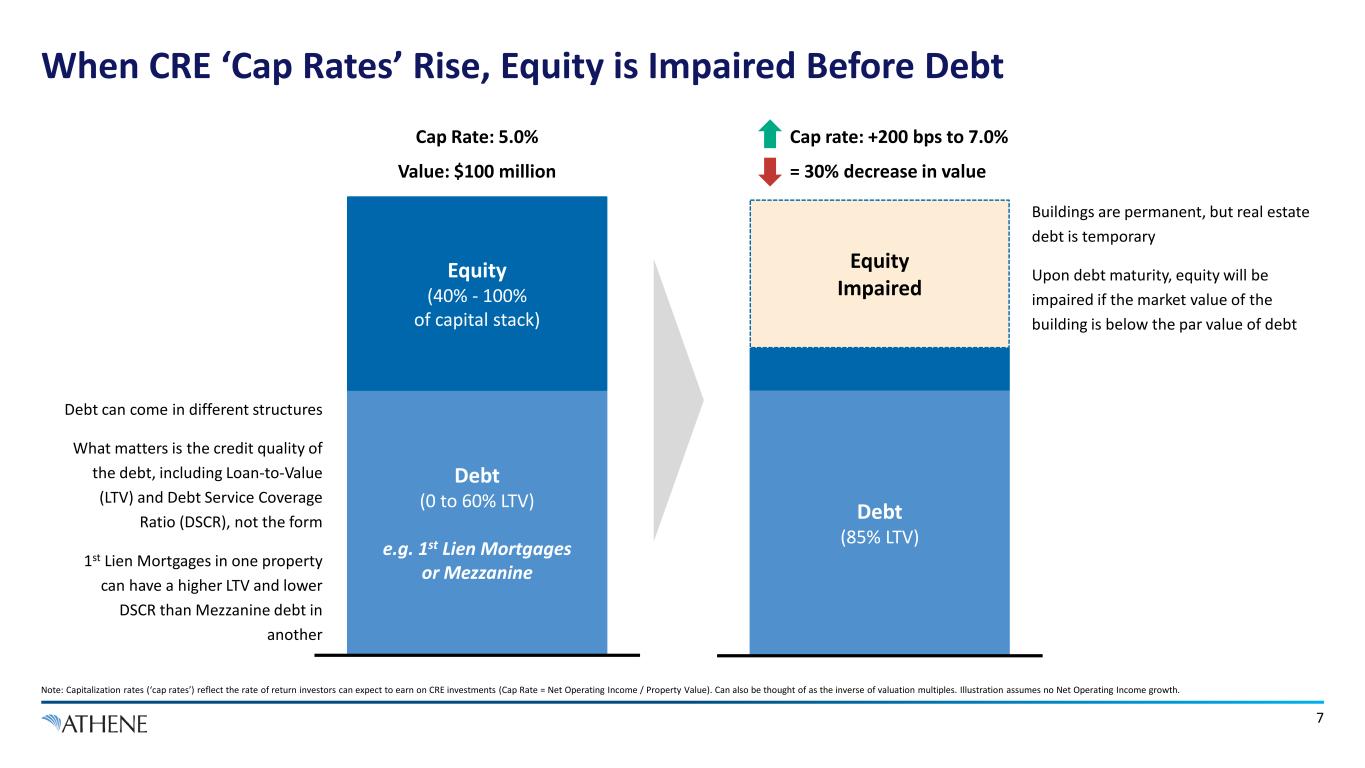
When CRE ‘Cap Rates’ Rise, Equity is Impaired Before Debt Note: Capitalization rates (‘cap rates’) reflect the rate of return investors can expect to earn on CRE investments (Cap Rate = Net Operating Income / Property Value). Can also be thought of as the inverse of valuation multiples. Illustration assumes no Net Operating Income growth. 7 Cap Rate: 5.0% Value: $100 million Cap rate: +200 bps to 7.0% = 30% decrease in value Buildings are permanent, but real estate debt is temporary Upon debt maturity, equity will be impaired if the market value of the building is below the par value of debt Debt (0 to 60% LTV) e.g. 1st Lien Mortgages or Mezzanine Equity (40% - 100% of capital stack) Debt (85% LTV) Equity Impaired Debt can come in different structures What matters is the credit quality of the debt, including Loan-to-Value (LTV) and Debt Service Coverage Ratio (DSCR), not the form 1st Lien Mortgages in one property can have a higher LTV and lower DSCR than Mezzanine debt in another
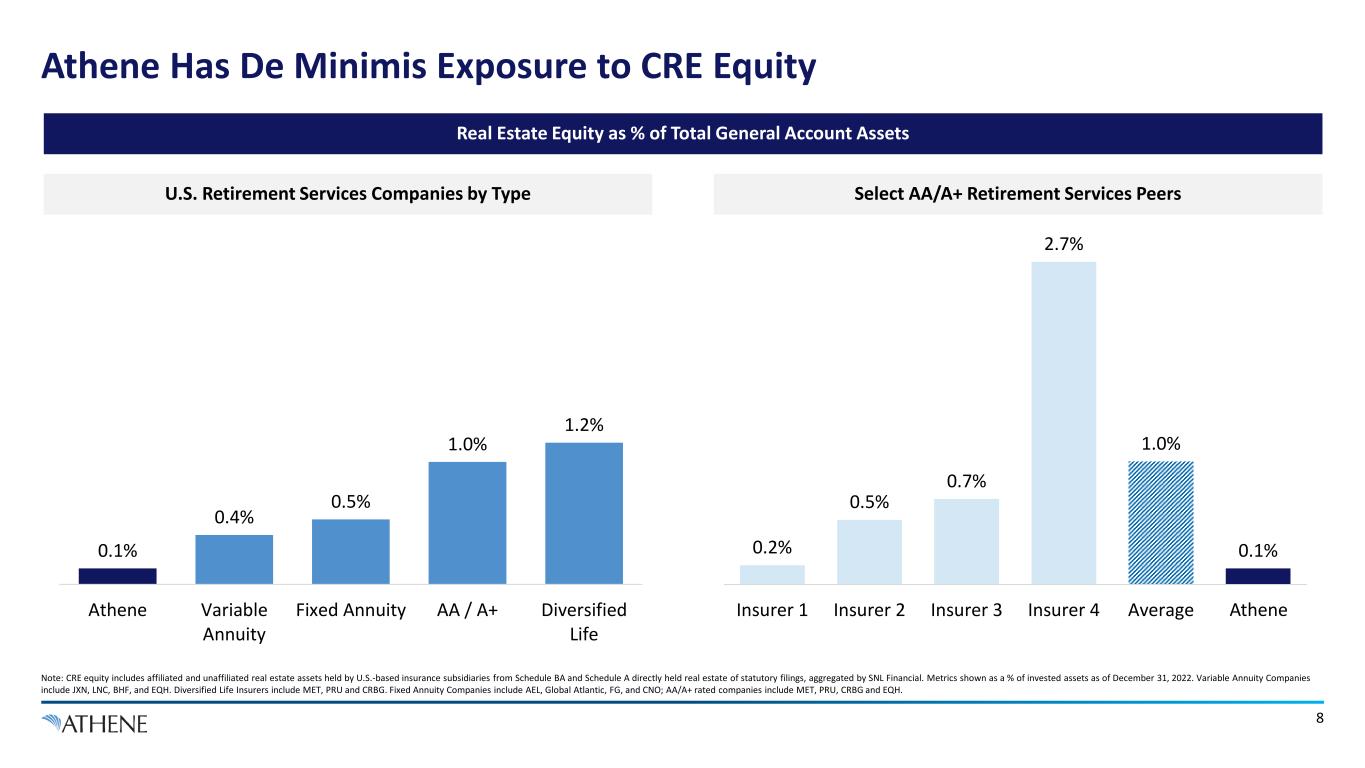
0.2% 0.5% 0.7% 2.7% 1.0% 0.1% Insurer 1 Insurer 2 Insurer 3 Insurer 4 Average ATH 0.1% 0.4% 0.5% 1.0% 1.2% Athene Variable Annuity Fixed Annuity AA / A+ Diversified Life Athene Has De Minimis Exposure to CRE Equity Note: CRE equity includes affiliated and unaffiliated real estate assets held by U.S.-based insurance subsidiaries from Schedule BA and Schedule A directly held real estate of statutory filings, aggregated by SNL Financial. Metrics shown as a % of invested assets as of December 31, 2022. Variable Annuity Companies include JXN, LNC, BHF, and EQH. Diversified Life Insurers include MET, PRU and CRBG. Fixed Annuity Companies include AEL, Global Atlantic, FG, and CNO; AA/A+ rated companies include MET, PRU, CRBG and EQH. 8 Real Estate Equity as % of Total General Account Assets U.S. Retirement Services Companies by Type Select AA/A+ Retirement Services Peers Athene
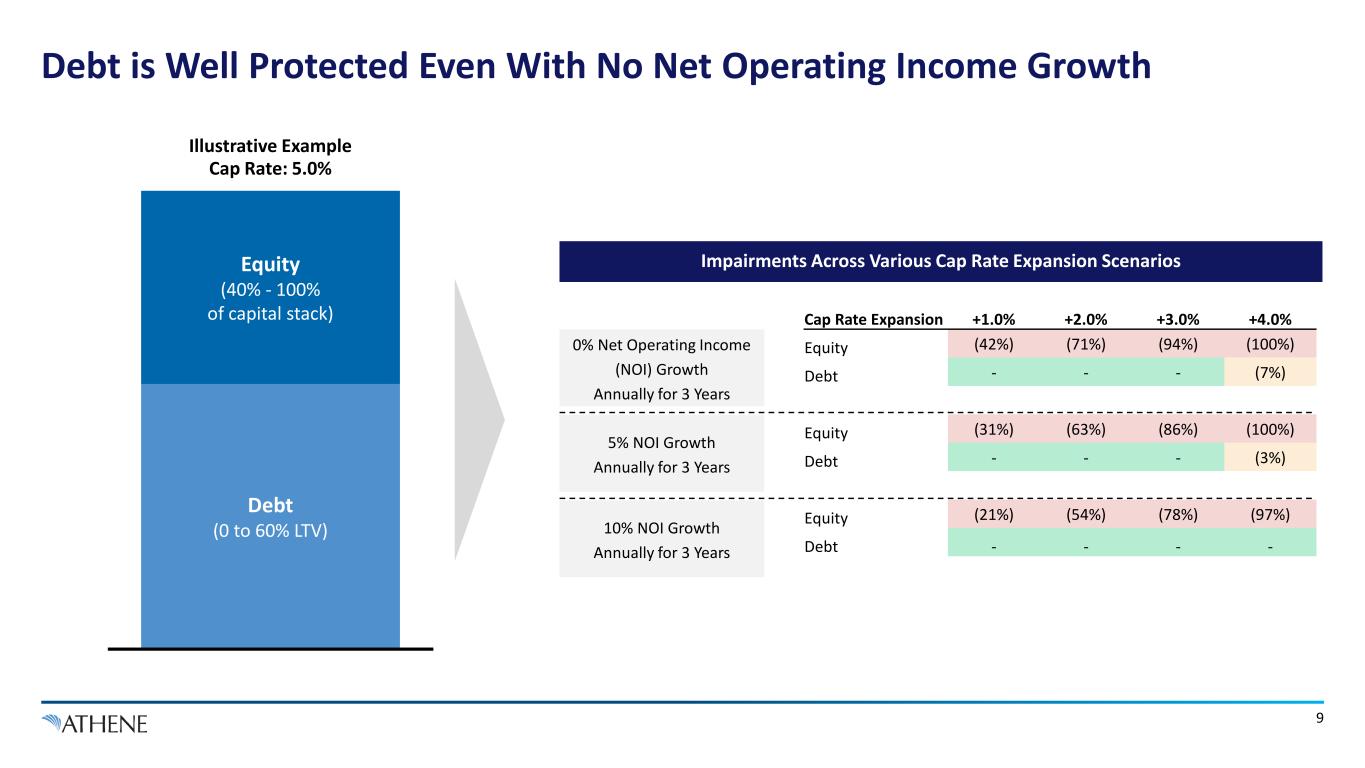
Debt is Well Protected Even With No Net Operating Income Growth 9 0% Net Operating Income (NOI) Growth Annually for 3 Years 5% NOI Growth Annually for 3 Years 10% NOI Growth Annually for 3 Years Impairments Across Various Cap Rate Expansion Scenarios Cap Rate: 5.0% Debt (0 to 60% LTV) Equity (40% - 100% of capital stack) Cap Rate Expansion +1.0% +2.0% +3.0% +4.0% Equity (42%) (71%) (94%) (100%) Debt - - - (7%) Equity (31%) (63%) (86%) (100%) Debt - - - (3%) Equity (21%) (54%) (78%) (97%) Debt - - - - Illustrative Example
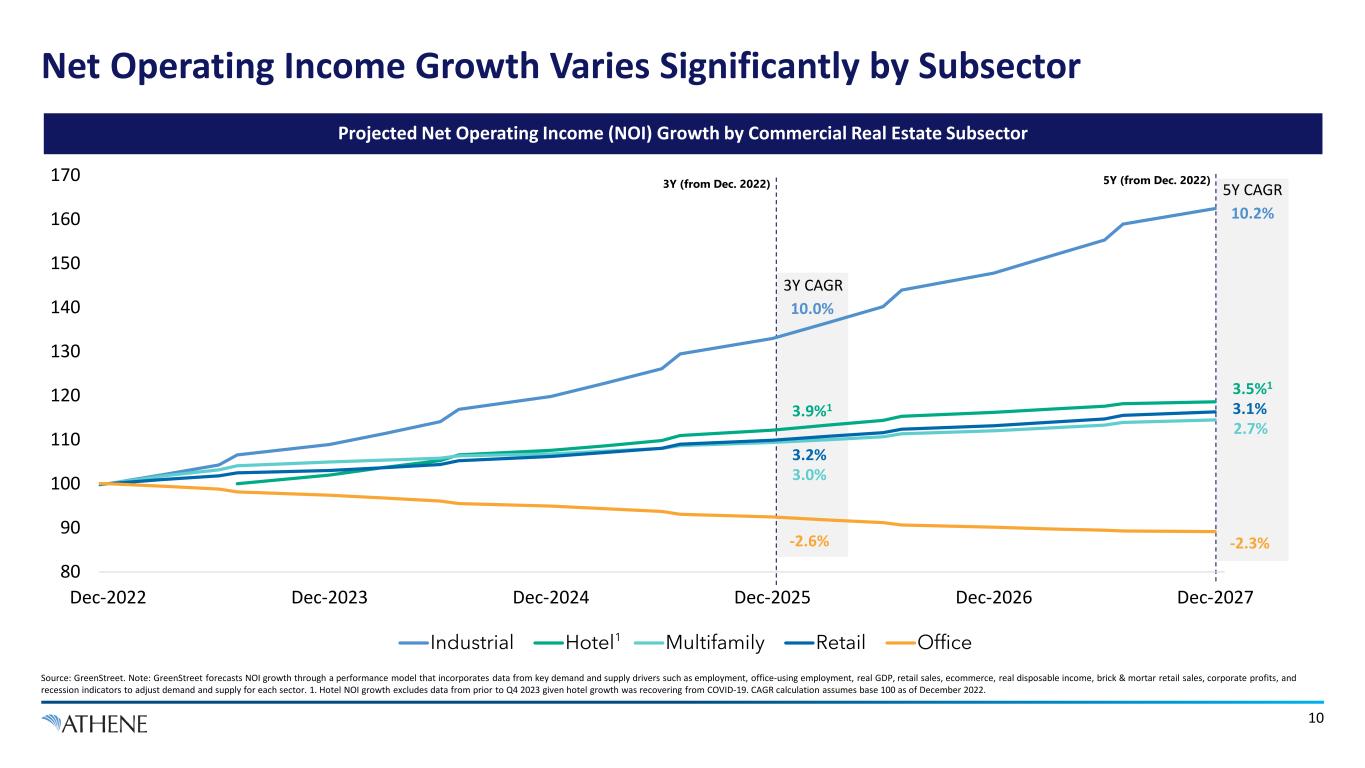
Net Operating Income Growth Varies Significantly by Subsector 10 80 90 100 110 120 130 140 150 160 170 Dec-2022 Dec-2023 Dec-2024 Dec-2025 Dec-2026 Dec-2027 Industrial Hotel Multifamily Retail Office 3Y (from Dec. 2022) 5Y (from Dec. 2022) Source: GreenStreet. Note: GreenStreet forecasts NOI growth through a performance model that incorporates data from key demand and supply drivers such as employment, office-using employment, real GDP, retail sales, ecommerce, real disposable income, brick & mortar retail sales, corporate profits, and recession indicators to adjust demand and supply for each sector. 1. Hotel NOI growth excludes data from prior to Q4 2023 given hotel growth was recovering from COVID-19. CAGR calculation assumes base 100 as of December 2022. Projected Net Operating Income (NOI) Growth by Commercial Real Estate Subsector 1 3Y CAGR 10.0% 3.9%1 3.0% 3.2% -2.6% 10.2% 3.5%1 2.7% 3.1% -2.3% 5Y CAGR
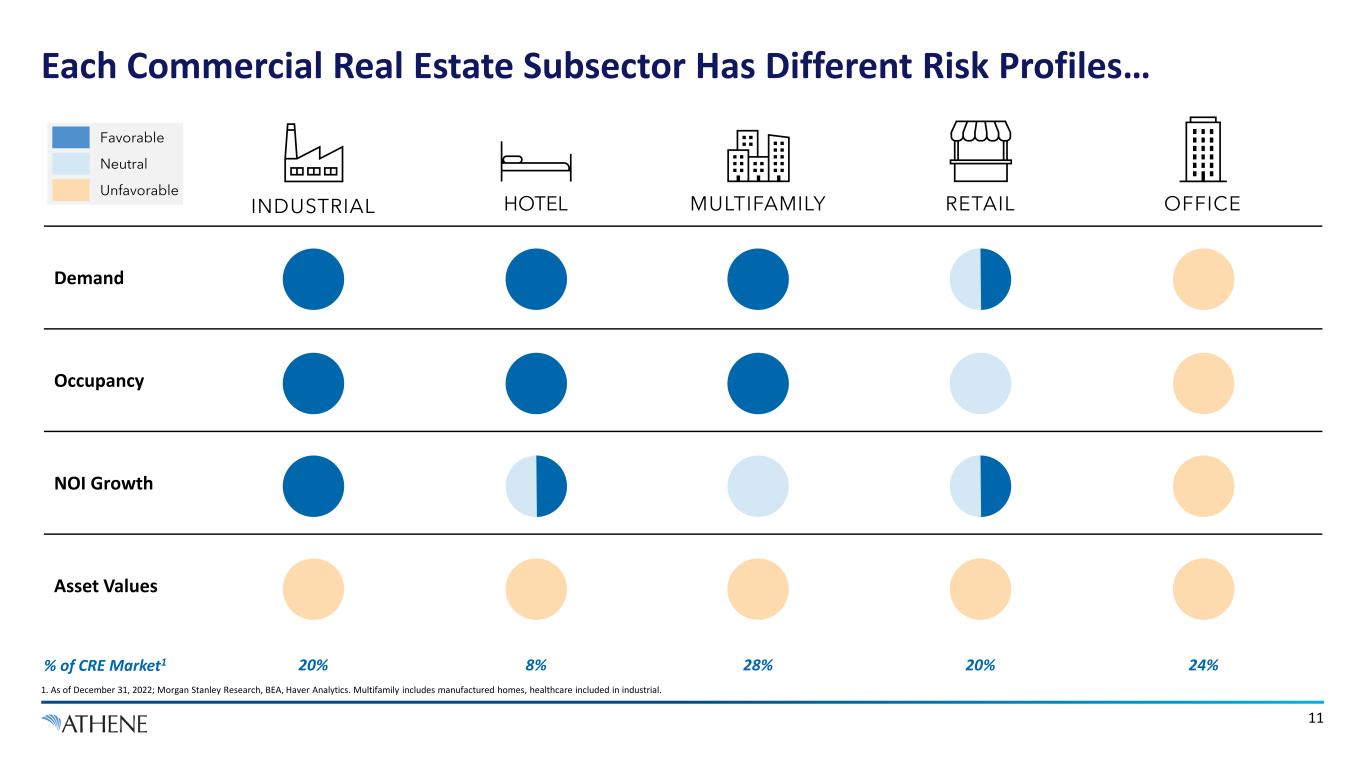
Each Commercial Real Estate Subsector Has Different Risk Profiles… 1. As of December 31, 2022; Morgan Stanley Research, BEA, Haver Analytics. Multifamily includes manufactured homes, healthcare included in industrial. 11 Demand Occupancy NOI Growth Asset Values % of CRE Market1 HOTEL 8% INDUSTRIAL 20% OFFICE 24% MULTIFAMILY 28% RETAIL 20% Favorable Neutral Unfavorable
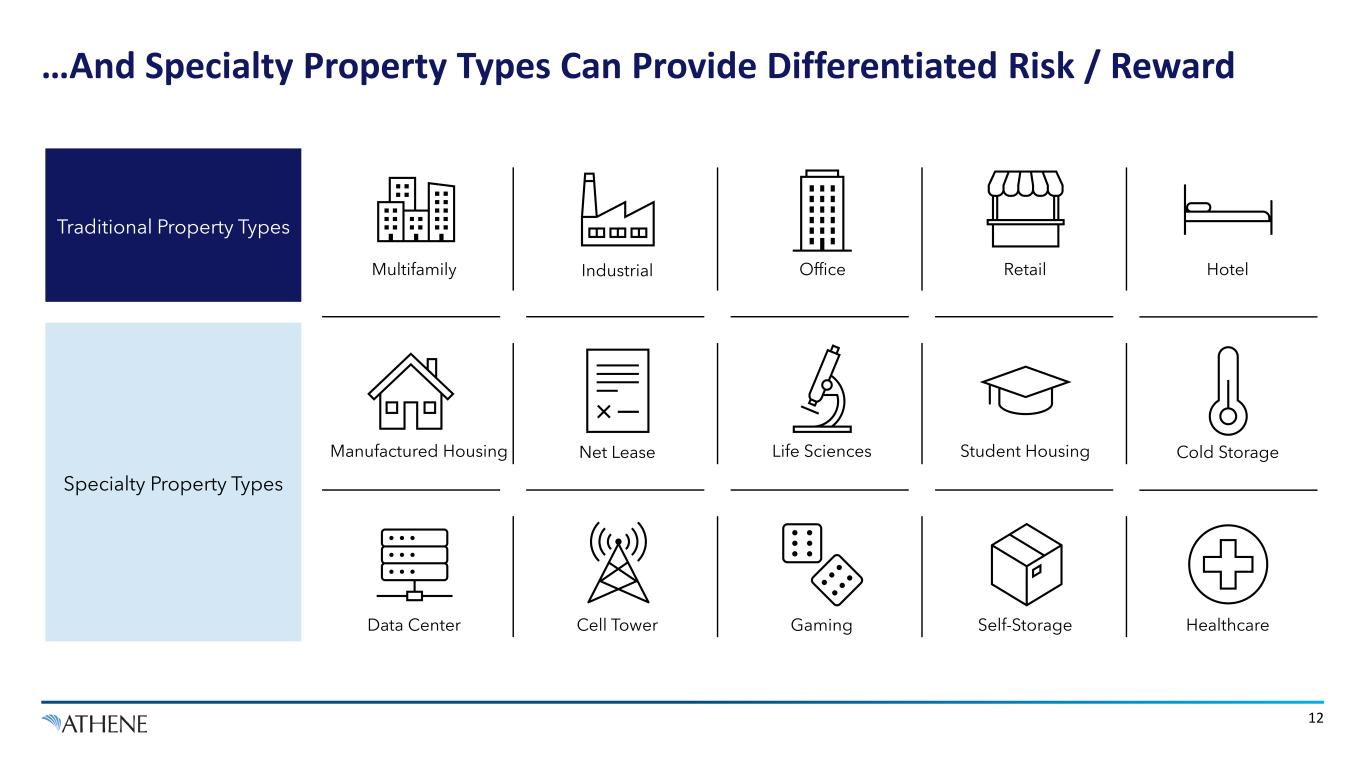
…And Specialty Property Types Can Provide Differentiated Risk / Reward 12 Traditional Property Types Specialty Property Types Industrial Manufactured Housing RetailOffice Life Sciences Student HousingNet Lease Self-StorageData Center Cold Storage HealthcareGamingCell Tower HotelMultifamily
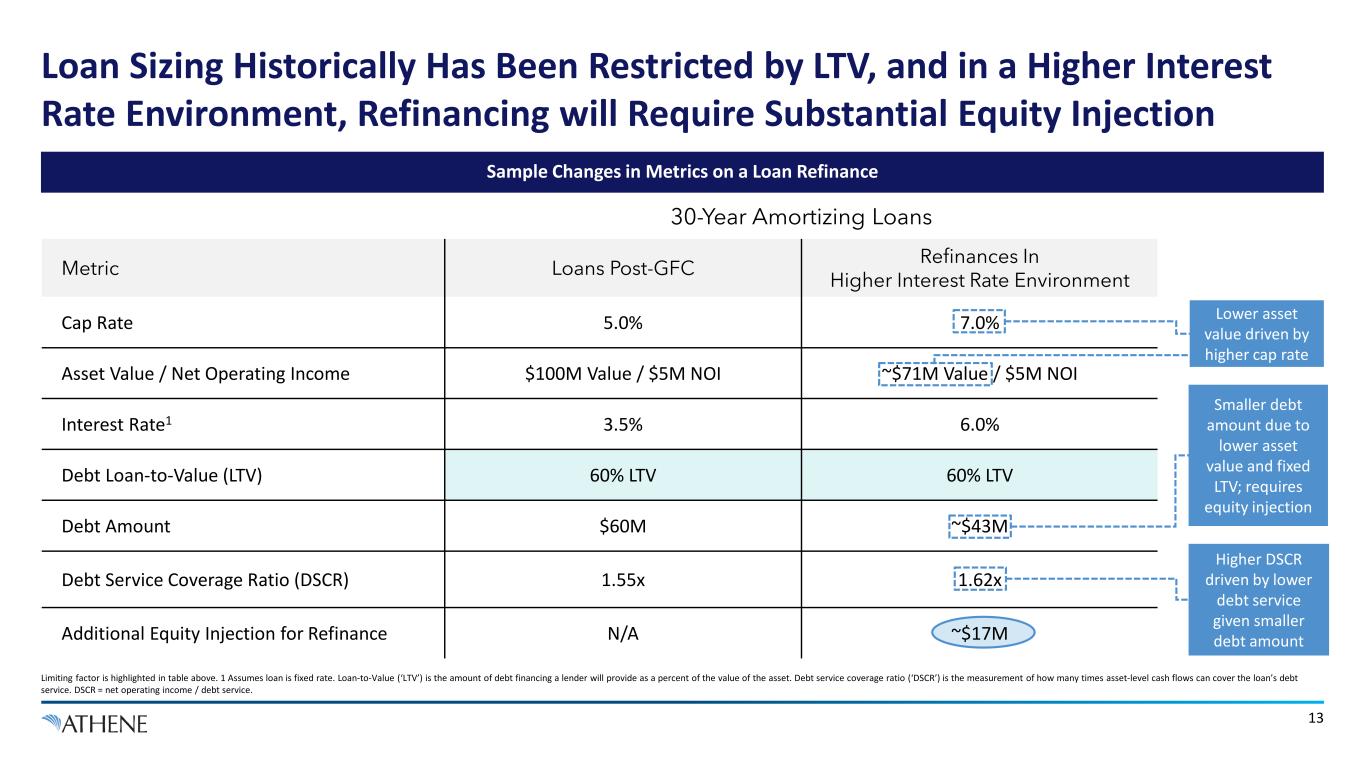
Loan Sizing Historically Has Been Restricted by LTV, and in a Higher Interest Rate Environment, Refinancing will Require Substantial Equity Injection Limiting factor is highlighted in table above. 1 Assumes loan is fixed rate. Loan-to-Value (‘LTV’) is the amount of debt financing a lender will provide as a percent of the value of the asset. Debt service coverage ratio (‘DSCR’) is the measurement of how many times asset-level cash flows can cover the loan’s debt service. DSCR = net operating income / debt service. 13 Sample Changes in Metrics on a Loan Refinance Higher DSCR driven by lower debt service given smaller debt amount Lower asset value driven by higher cap rate Smaller debt amount due to lower asset value and fixed LTV; requires equity injection 30-Year Amortizing Loans Metric Loans Post-GFC Refinances In Higher Interest Rate Environment Cap Rate 5.0% 7.0% Asset Value / Net Operating Income $100M Value / $5M NOI ~$71M Value / $5M NOI Interest Rate1 3.5% 6.0% Debt Loan-to-Value (LTV) 60% LTV 60% LTV Debt Amount $60M ~$43M Debt Service Coverage Ratio (DSCR) 1.55x 1.62x Additional Equity Injection for Refinance N/A ~$17M

Credit enhancement from equity Amortization Structural protections that trap cash to support debt in periods of stress Reserves set from cash flow to cover building operating costs Real Estate Debt Also Benefits From Significant Protection Via Loan Structure 14
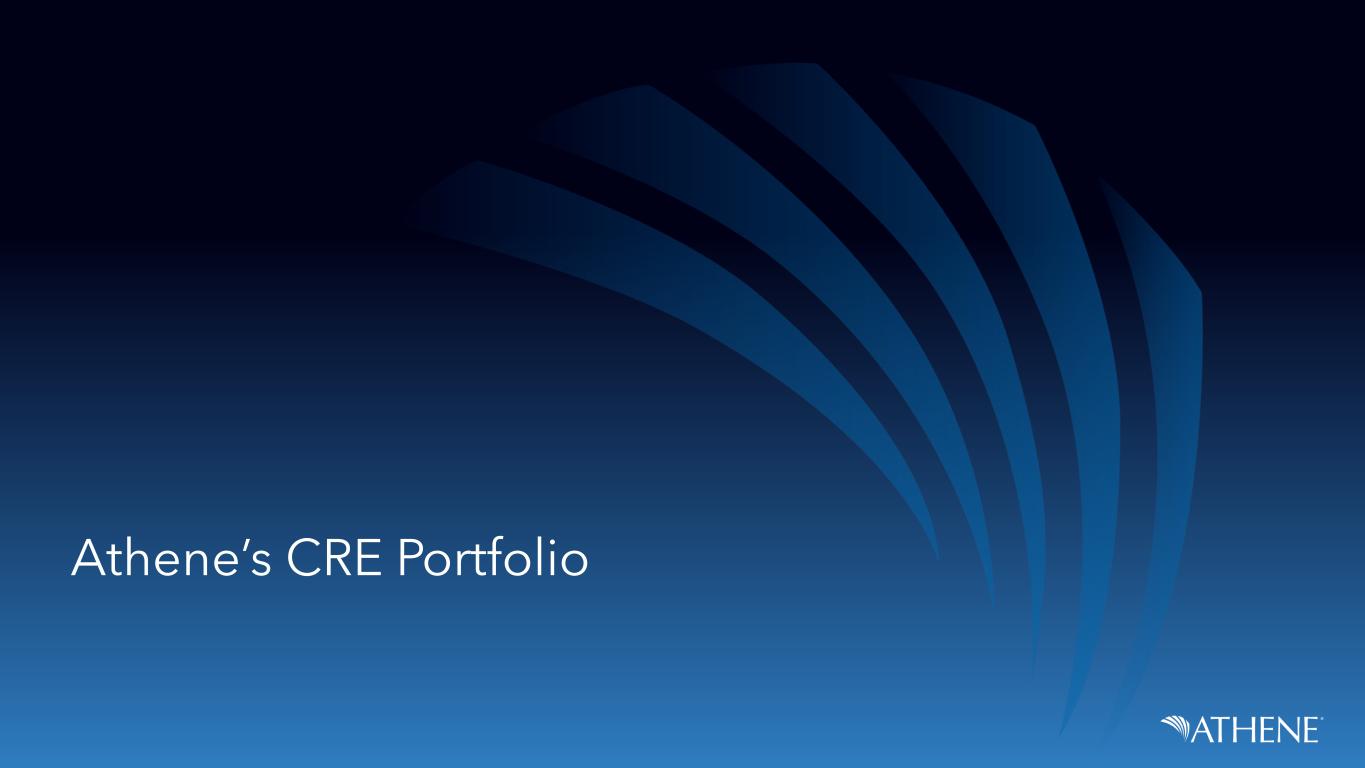
Athene’s CRE Portfolio
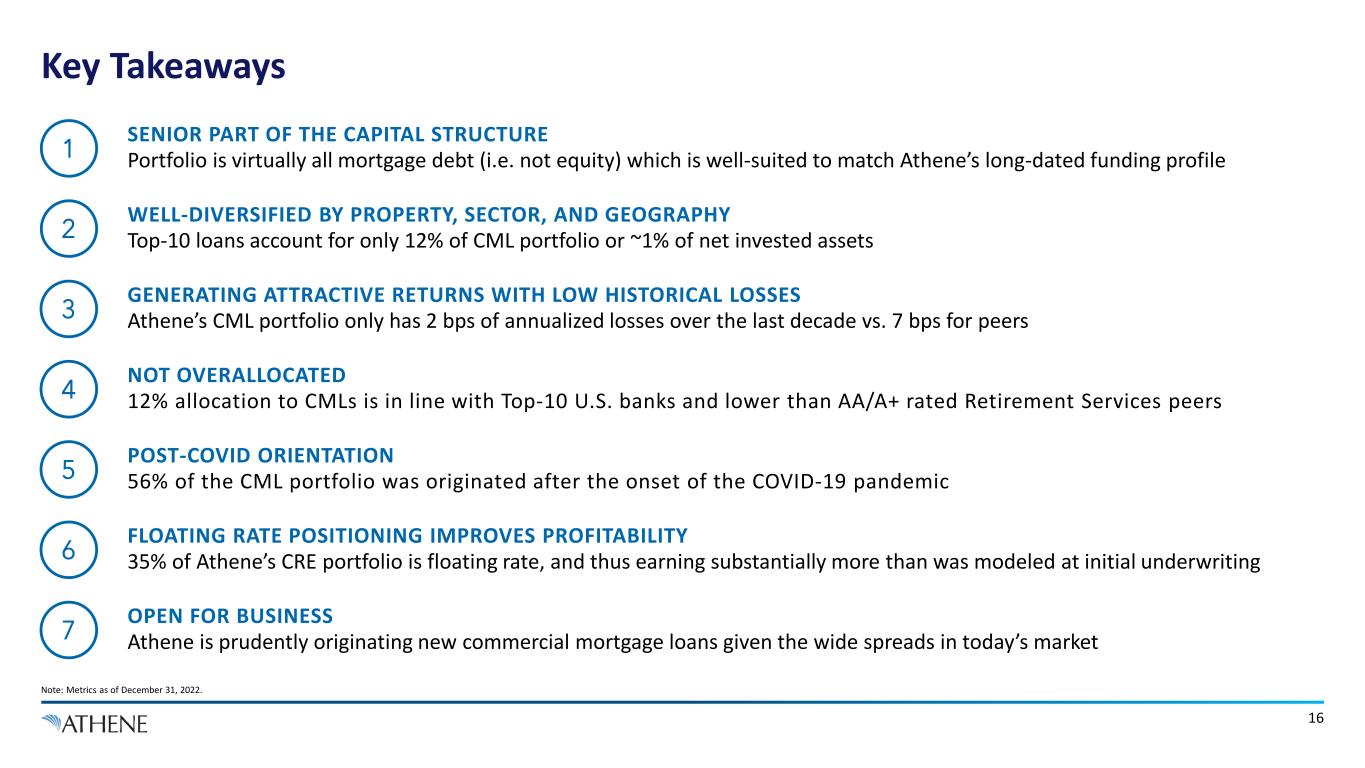
Key Takeaways Note: Metrics as of December 31, 2022. 16 GENERATING ATTRACTIVE RETURNS WITH LOW HISTORICAL LOSSES Athene’s CML portfolio only has 2 bps of annualized losses over the last decade vs. 7 bps for peers3 POST-COVID ORIENTATION 56% of the CML portfolio was originated after the onset of the COVID-19 pandemic5 SENIOR PART OF THE CAPITAL STRUCTURE Portfolio is virtually all mortgage debt (i.e. not equity) which is well-suited to match Athene’s long-dated funding profile 1 NOT OVERALLOCATED 12% allocation to CMLs is in line with Top-10 U.S. banks and lower than AA/A+ rated Retirement Services peers4 FLOATING RATE POSITIONING IMPROVES PROFITABILITY 35% of Athene’s CRE portfolio is floating rate, and thus earning substantially more than was modeled at initial underwriting6 OPEN FOR BUSINESS Athene is prudently originating new commercial mortgage loans given the wide spreads in today’s market7 2 WELL-DIVERSIFIED BY PROPERTY, SECTOR, AND GEOGRAPHY Top-10 loans account for only 12% of CML portfolio or ~1% of net invested assets

Athene’s CRE Investments Are Virtually All Debt… Note: Metrics based on GAAP net invested assets as of December 31, 2022. Variable Annuity Companies include JXN, LNC, BHF, and EQH. Diversified Life Insurers include MET, PRU and CRBG. Fixed Annuity Companies include AEL, Global Atlantic, FG, and CNO; AA/A+ rated companies include MET, PRU, CRBG and EQH. 17 Total CRE Debt Plus Equity as % of General Account Assets U.S. Retirement Services Companies by Type Select AA/A+ Retirement Services Peers 8.2% 12.1% 11.6% 12.3% 13.4% 1.2% 1.0% 8.7% 12.2% 12.8% 13.3% 13.8% Fixed Annuity Athene Diversified Life AA / A+ Variable Annuity CRE Debt CRE Equity 9.8% 13.4% 11.6% 14.4% 12.1% 12.3% 0.7% 2.7% 1.0% 10.0% 14.1% 14.3% 14.9% 12.2% 13.3% PRU CRBG MET EQH ATH Average CRE Debt CRE Equity Rated
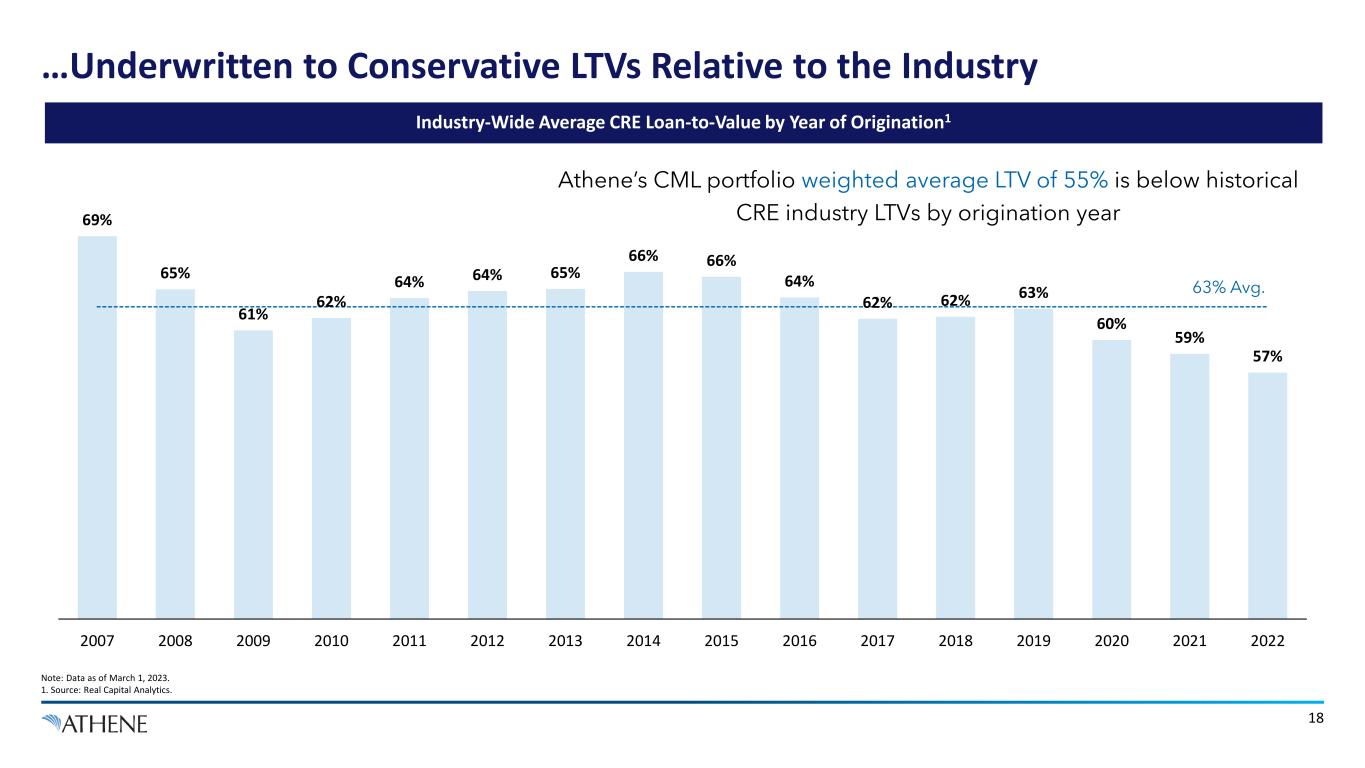
…Underwritten to Conservative LTVs Relative to the Industry Note: Data as of March 1, 2023. 1. Source: Real Capital Analytics. 18 Industry-Wide Average CRE Loan-to-Value by Year of Origination1 69% 65% 61% 62% 64% 64% 65% 66% 66% 64% 62% 62% 63% 60% 59% 57% 63% Avg. 2007 2008 2009 2010 2011 2012 2013 2014 2015 2016 2017 2018 2019 2020 2021 2022 Athene’s CML portfolio weighted average LTV of 55% is below historical CRE industry LTVs by origination year
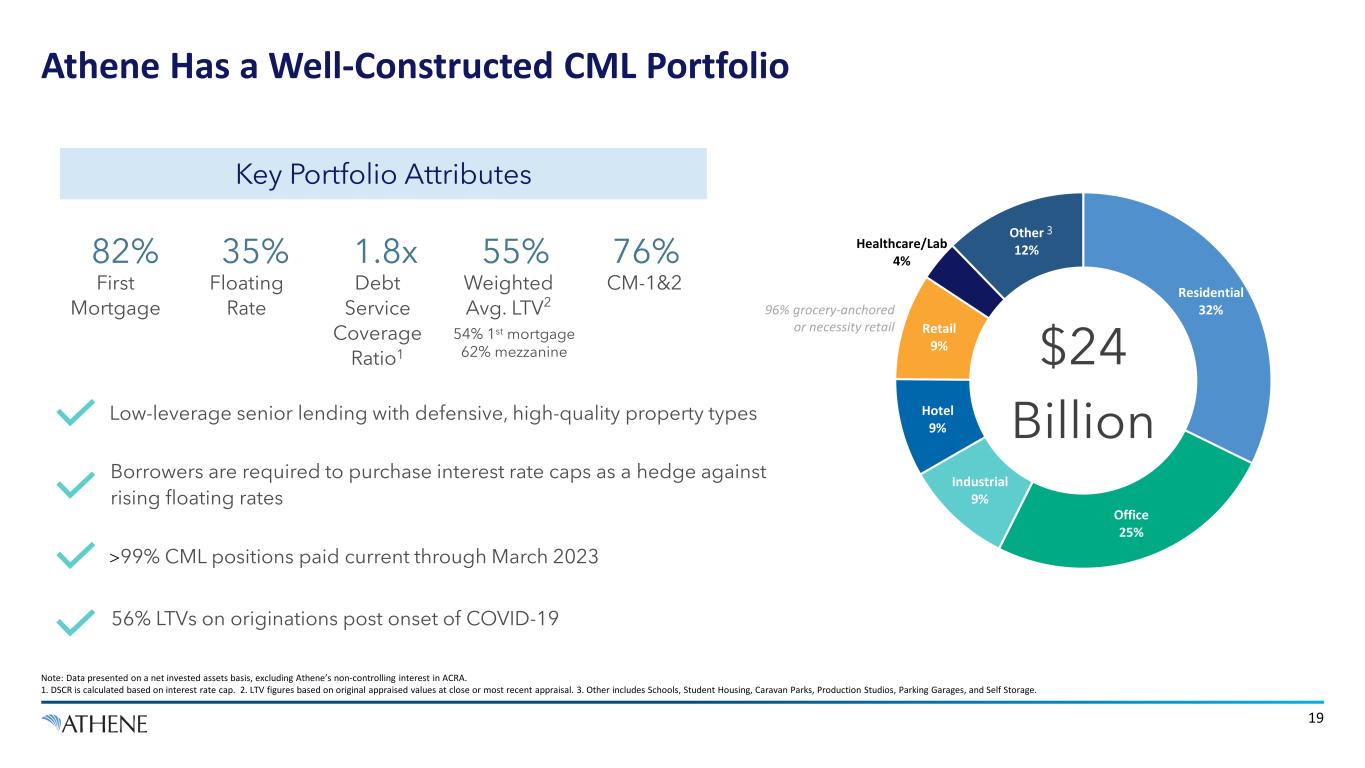
Athene Has a Well-Constructed CML Portfolio Note: Data presented on a net invested assets basis, excluding Athene’s non-controlling interest in ACRA. 1. DSCR is calculated based on interest rate cap. 2. LTV figures based on original appraised values at close or most recent appraisal. 3. Other includes Schools, Student Housing, Caravan Parks, Production Studios, Parking Garages, and Self Storage. 19 Key Portfolio Attributes Low-leverage senior lending with defensive, high-quality property types $24 Billion Borrowers are required to purchase interest rate caps as a hedge against rising floating rates Residential 32% Office 25% Industrial 9% Hotel 9% Retail 9% Healthcare/Lab 4% Other 12% 3 >99% CML positions paid current through March 2023 82% First Mortgage 1.8x Debt Service Coverage Ratio1 55% Weighted Avg. LTV2 76% CM-1&2 35% Floating Rate 54% 1st mortgage 62% mezzanine 56% LTVs on originations post onset of COVID-19 96% grocery-anchored or necessity retail

Portfolio Quality Improved Throughout COVID Pandemic Note: Data presented net of Athene’s non-controlling interest in ACRA. 20 27% 25% 2019 2022 22% 9% 2019 2022 $13B or 56% of Athene’s CMLs were originated after the onset of the COVID-19 pandemic % of Portfolio Designated CM 1 & 2 Retail Sector as % of Portfolio Office Sector as % of Portfolio 72% 76% 2019 2022
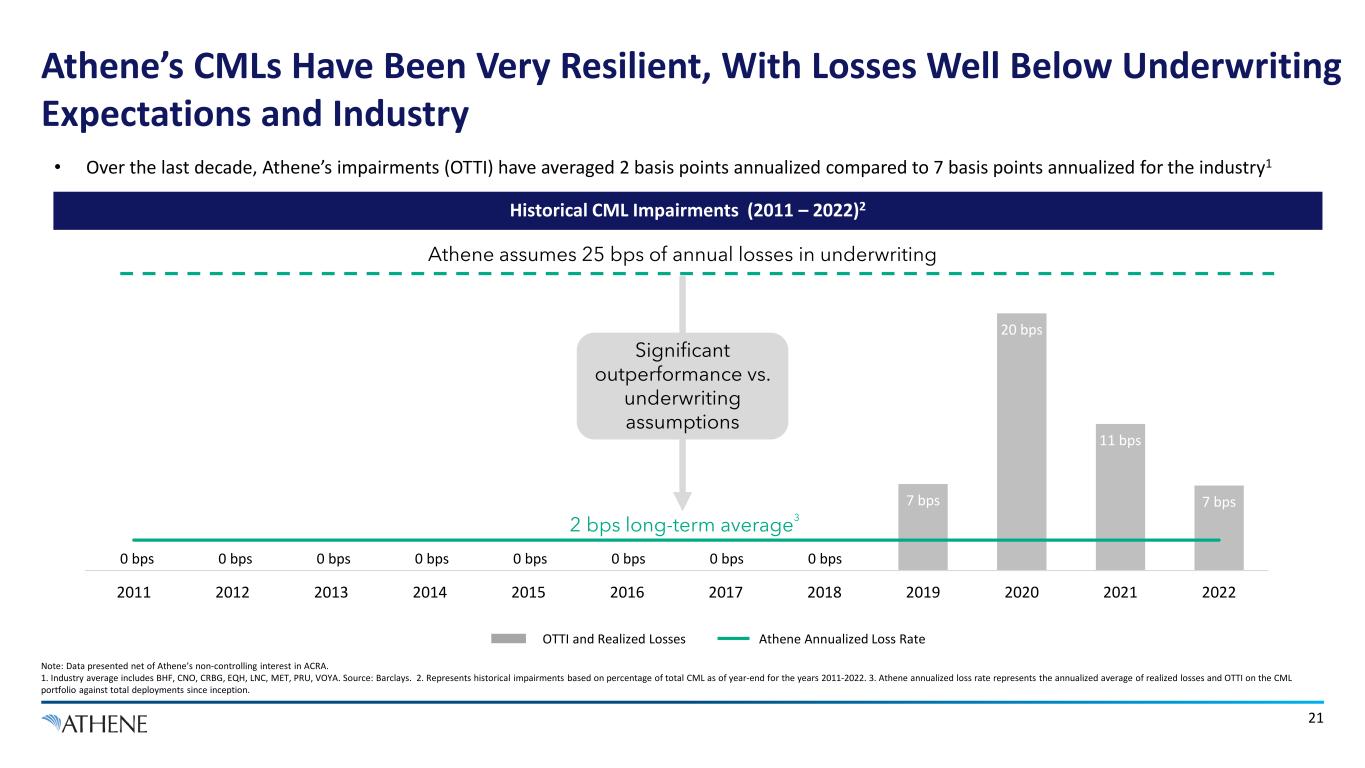
Athene’s CMLs Have Been Very Resilient, With Losses Well Below Underwriting Expectations and Industry Note: Data presented net of Athene’s non-controlling interest in ACRA. 1. Industry average includes BHF, CNO, CRBG, EQH, LNC, MET, PRU, VOYA. Source: Barclays. 2. Represents historical impairments based on percentage of total CML as of year-end for the years 2011-2022. 3. Athene annualized loss rate represents the annualized average of realized losses and OTTI on the CML portfolio against total deployments since inception. 21 7 bps 20 bps 11 bps 7 bps 2 bps long-term average 2011 2012 2013 2014 2015 2016 2017 2018 2019 2020 2021 2022 Athene Annualized Loss Rate 0 bps 0 bps 0 bps 0 bps 0 bps 0 bps 0 bps 0 bps • Over the last decade, Athene’s impairments (OTTI) have averaged 2 basis points annualized compared to 7 basis points annualized for the industry1 OTTI and Realized Losses Athen Annualized Loss Rate 3 Athene assumes 25 bps of annual losses in underwriting Historical CML Impairments (2011 – 2022)2 Significant outperformance vs. underwriting assumptions
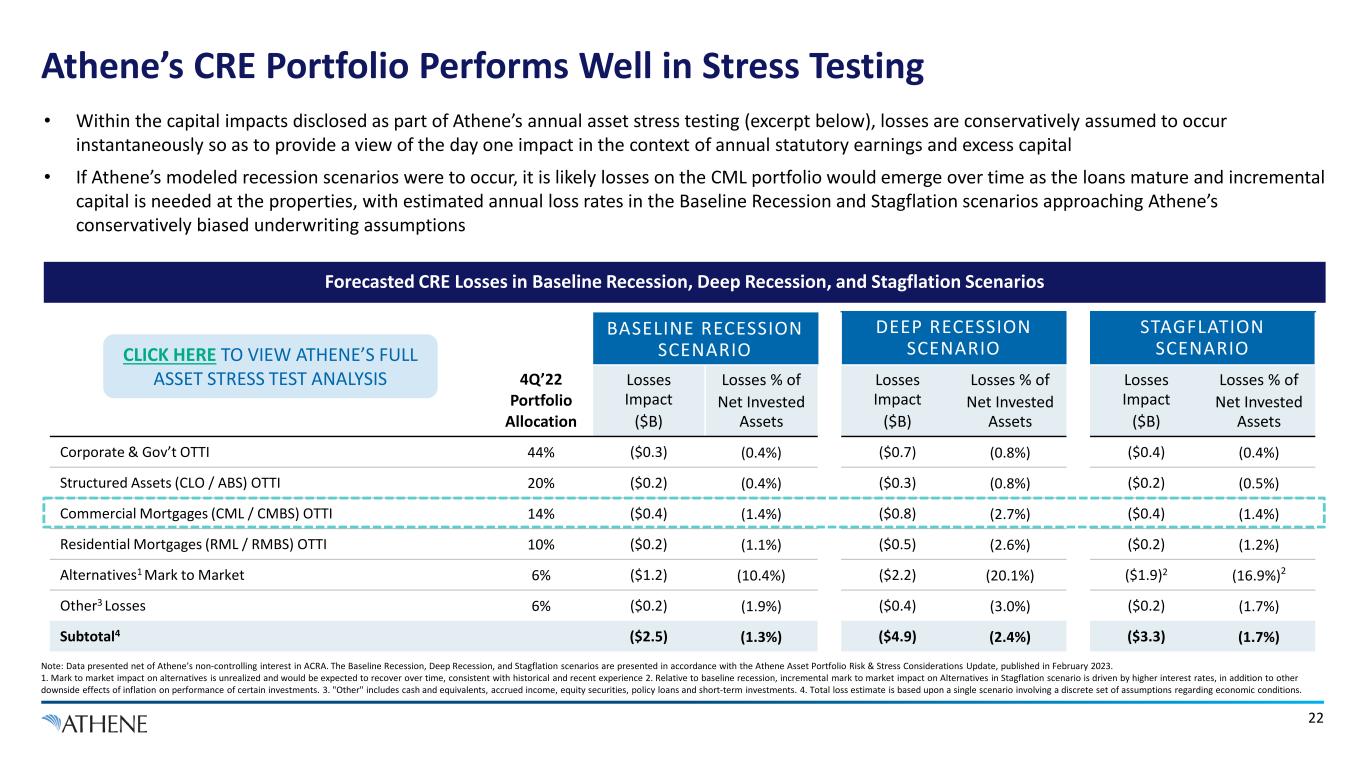
4Q’22 Portfolio Allocation BASELINE RECESSION SCENARIO DEEP RECESSION SCENARIO STAGFLATION SCENARIO Losses Impact ($B) Losses % of Net Invested Assets Losses Impact ($B) Losses % of Net Invested Assets Losses Impact ($B) Losses % of Net Invested Assets Corporate & Gov’t OTTI 44% ($0.3) (0.4%) ($0.7) (0.8%) ($0.4) (0.4%) Structured Assets (CLO / ABS) OTTI 20% ($0.2) (0.4%) ($0.3) (0.8%) ($0.2) (0.5%) Commercial Mortgages (CML / CMBS) OTTI 14% ($0.4) (1.4%) ($0.8) (2.7%) ($0.4) (1.4%) Residential Mortgages (RML / RMBS) OTTI 10% ($0.2) (1.1%) ($0.5) (2.6%) ($0.2) (1.2%) Alternatives1 Mark to Market 6% ($1.2) (10.4%) ($2.2) (20.1%) ($1.9)2 (16.9%)2 Other3 Losses 6% ($0.2) (1.9%) ($0.4) (3.0%) ($0.2) (1.7%) Subtotal4 ($2.5) (1.3%) ($4.9) (2.4%) ($3.3) (1.7%) Athene’s CRE Portfolio Performs Well in Stress Testing Note: Data presented net of Athene’s non-controlling interest in ACRA. The Baseline Recession, Deep Recession, and Stagflation scenarios are presented in accordance with the Athene Asset Portfolio Risk & Stress Considerations Update, published in February 2023. 1. Mark to market impact on alternatives is unrealized and would be expected to recover over time, consistent with historical and recent experience 2. Relative to baseline recession, incremental mark to market impact on Alternatives in Stagflation scenario is driven by higher interest rates, in addition to other downside effects of inflation on performance of certain investments. 3. "Other" includes cash and equivalents, accrued income, equity securities, policy loans and short-term investments. 4. Total loss estimate is based upon a single scenario involving a discrete set of assumptions regarding economic conditions. 22 Forecasted CRE Losses in Baseline Recession, Deep Recession, and Stagflation Scenarios • Within the capital impacts disclosed as part of Athene’s annual asset stress testing (excerpt below), losses are conservatively assumed to occur instantaneously so as to provide a view of the day one impact in the context of annual statutory earnings and excess capital • If Athene’s modeled recession scenarios were to occur, it is likely losses on the CML portfolio would emerge over time as the loans mature and incremental capital is needed at the properties, with estimated annual loss rates in the Baseline Recession and Stagflation scenarios approaching Athene’s conservatively biased underwriting assumptions CLICK HERE TO VIEW ATHENE’S FULL ASSET STRESS TEST ANALYSIS
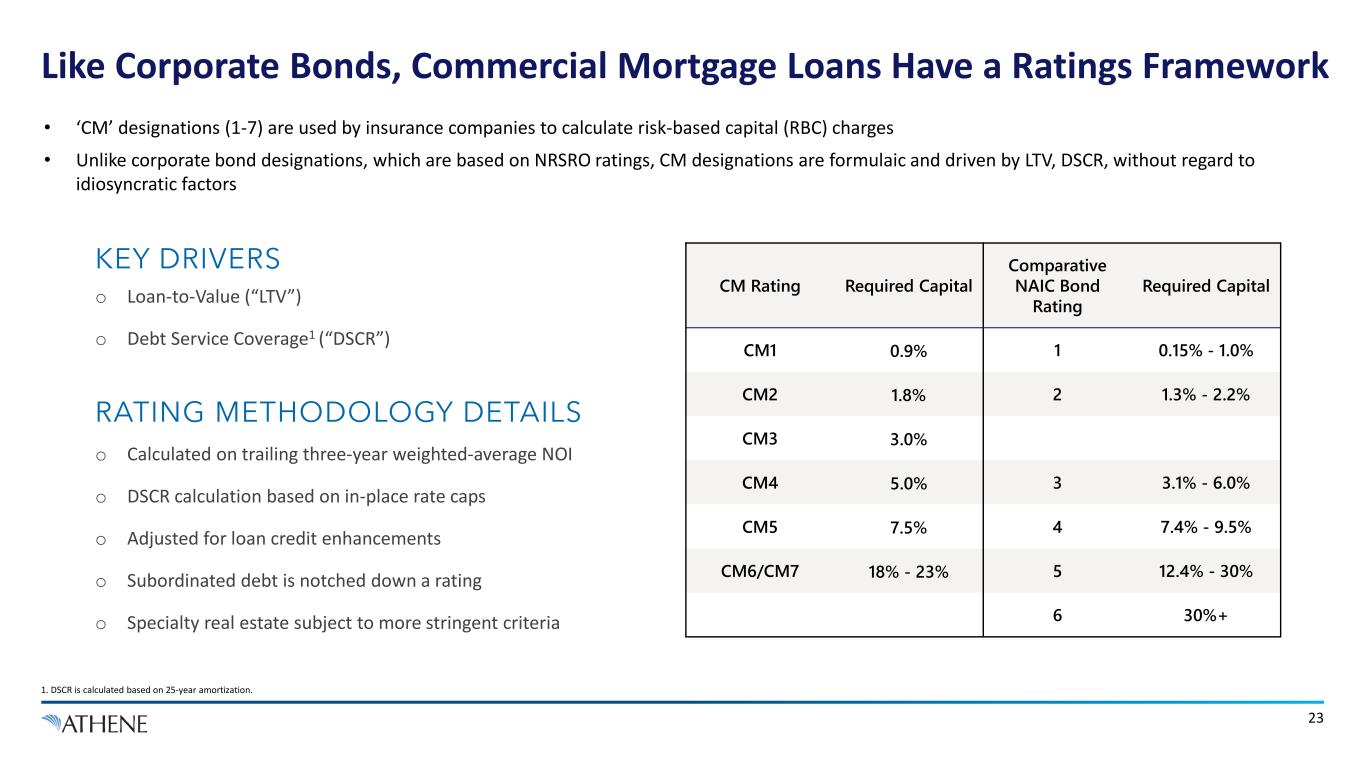
Like Corporate Bonds, Commercial Mortgage Loans Have a Ratings Framework 23 • ‘CM’ designations (1-7) are used by insurance companies to calculate risk-based capital (RBC) charges • Unlike corporate bond designations, which are based on NRSRO ratings, CM designations are formulaic and driven by LTV, DSCR, without regard to idiosyncratic factors RATING METHODOLOGY DETAILS o Calculated on trailing three-year weighted-average NOI o DSCR calculation based on in-place rate caps o Adjusted for loan credit enhancements o Subordinated debt is notched down a rating o Specialty real estate subject to more stringent criteria CM Rating Required Capital Comparative NAIC Bond Rating Required Capital CM1 0.9% 1 0.15% - 1.0% CM2 1.8% 2 1.3% - 2.2% CM3 3.0% CM4 5.0% 3 3.1% - 6.0% CM5 7.5% 4 7.4% - 9.5% CM6/CM7 18% - 23% 5 12.4% - 30% 6 30%+ KEY DRIVERS o Loan-to-Value (“LTV”) o Debt Service Coverage1 (“DSCR”) 1. DSCR is calculated based on 25-year amortization.
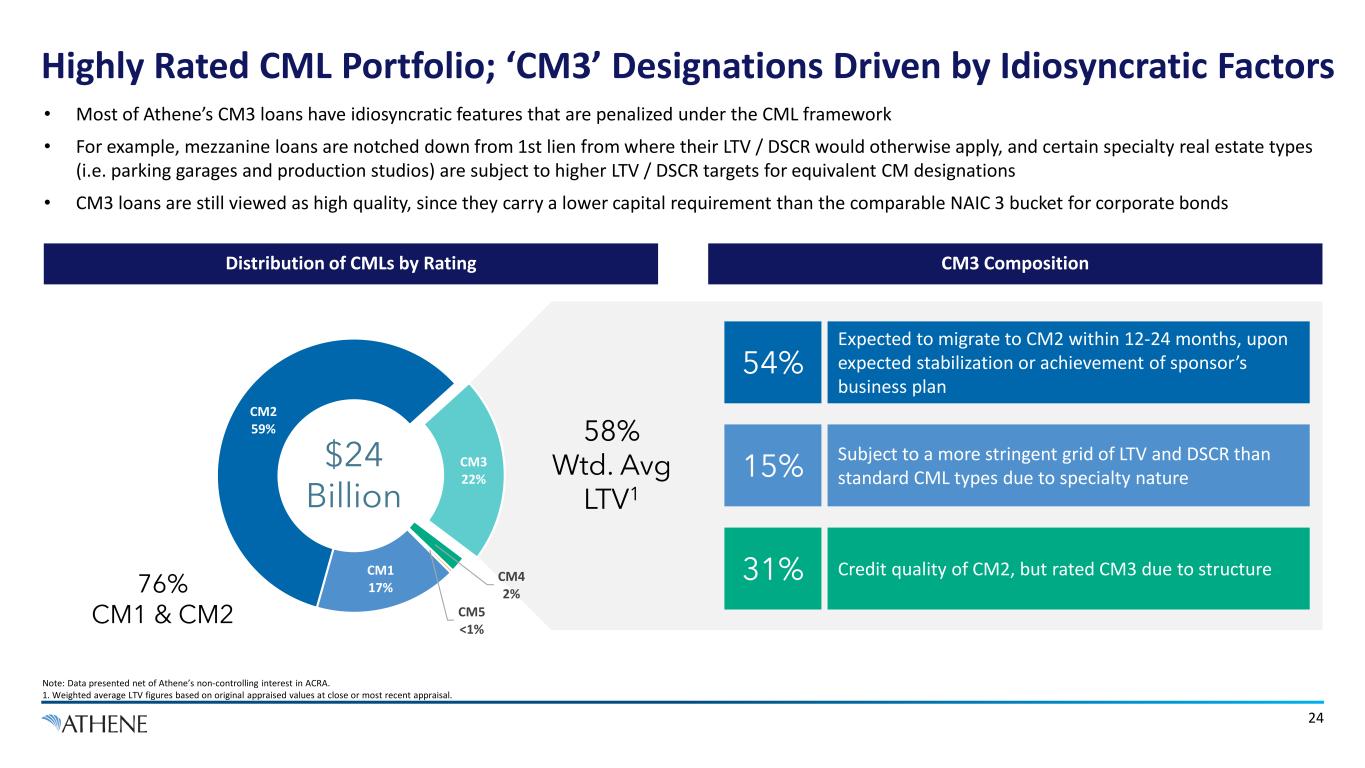
Highly Rated CML Portfolio; ‘CM3’ Designations Driven by Idiosyncratic Factors Note: Data presented net of Athene’s non-controlling interest in ACRA. 1. Weighted average LTV figures based on original appraised values at close or most recent appraisal. 24 CM1 17% CM2 59% CM3 22% CM4 2% CM5 <1% • Most of Athene’s CM3 loans have idiosyncratic features that are penalized under the CML framework • For example, mezzanine loans are notched down from 1st lien from where their LTV / DSCR would otherwise apply, and certain specialty real estate types (i.e. parking garages and production studios) are subject to higher LTV / DSCR targets for equivalent CM designations • CM3 loans are still viewed as high quality, since they carry a lower capital requirement than the comparable NAIC 3 bucket for corporate bonds 58% Wtd. Avg LTV1 76% CM1 & CM2 Expected to migrate to CM2 within 12-24 months, upon expected stabilization or achievement of sponsor’s business plan Subject to a more stringent grid of LTV and DSCR than standard CML types due to specialty nature Credit quality of CM2, but rated CM3 due to structure 54% 15% 31% $24 Billion 3 CM3 CompositionDistribution of CMLs by Rating
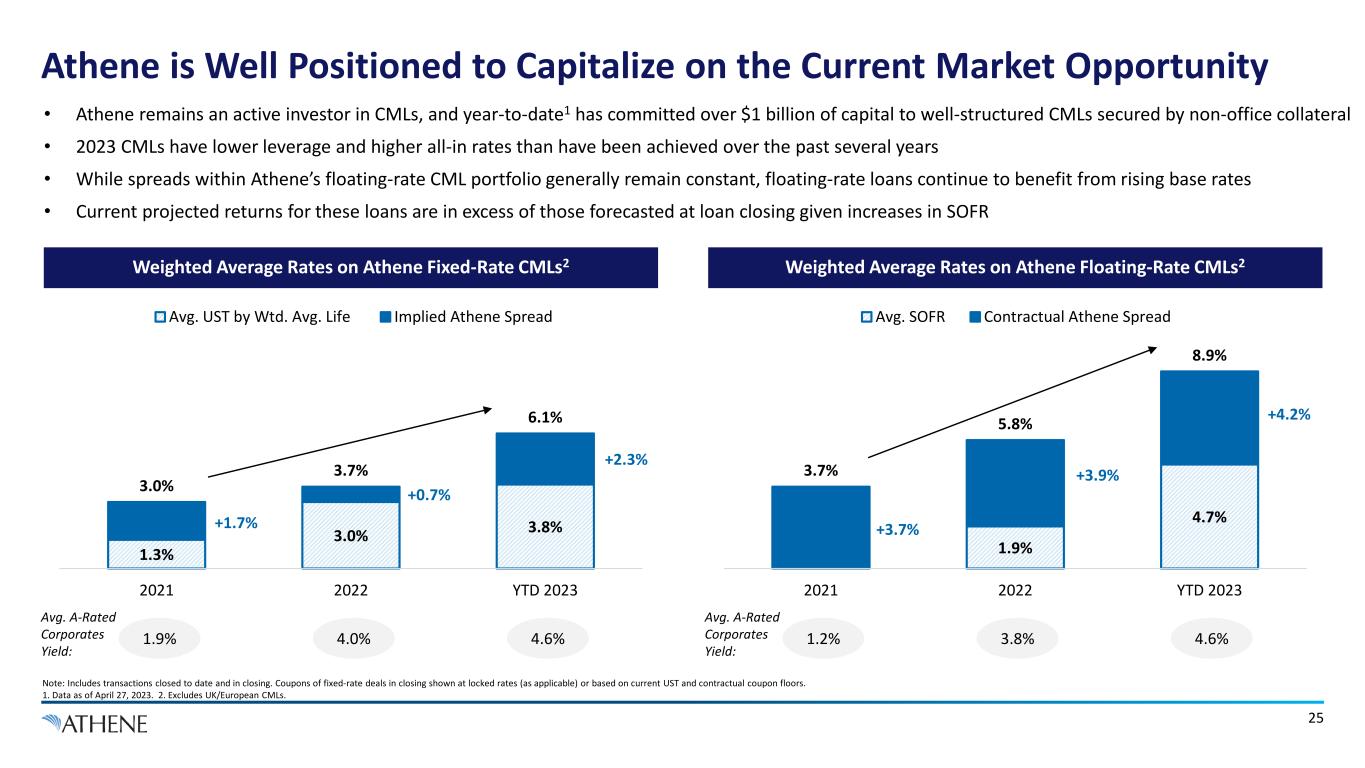
Athene is Well Positioned to Capitalize on the Current Market Opportunity Note: Includes transactions closed to date and in closing. Coupons of fixed-rate deals in closing shown at locked rates (as applicable) or based on current UST and contractual coupon floors. 1. Data as of April 27, 2023. 2. Excludes UK/European CMLs. 25 • Athene remains an active investor in CMLs, and year-to-date1 has committed over $1 billion of capital to well-structured CMLs secured by non-office collateral • 2023 CMLs have lower leverage and higher all-in rates than have been achieved over the past several years • While spreads within Athene’s floating-rate CML portfolio generally remain constant, floating-rate loans continue to benefit from rising base rates • Current projected returns for these loans are in excess of those forecasted at loan closing given increases in SOFR Weighted Average Rates on Athene Floating-Rate CMLs2Weighted Average Rates on Athene Fixed-Rate CMLs2 1.3% 3.0% 3.8%+1.7% +0.7% +2.3% 3.0% 3.7% 6.1% 2021 2022 YTD 2023 Avg. UST by Wtd. Avg. Life Implied Athene Spread 1.9% 4.0% 4.6% Avg. A-Rated Corporates Yield: 1.9% 4.7% +3.7% +3.9% +4.2% 3.7% 5.8% 8.9% 2021 2022 YTD 2023 Avg. SOFR Contractual Athene Spread 1.2% 3.8% 4.6% Avg. A-Rated Corporates Yield:

Athene’s CRE Office Investments

Class A CBD 75% Class B CBD 11% Suburban 11% Medical Office 3% Owner Occupied <1% Athene’s CML Office Investments are 100% Debt Note: Data presented net of Athene’s non-controlling interest in ACRA. 1. DSCR is calculated based on interest rate cap. 2. LTV figures based on original appraised values at close or most recent appraisal 3. CBD “Central Business District”. 27 Strong Credit Metrics and Structure 77% First Mortgage 1.9x Debt Service Coverage Ratio1 57% Weighted Avg LTV2 76% CM-1&2 23% CM-3 High Quality Sponsors with Deep Pockets Concentrated in Loans with Class A Assets and Long-Term Leases Proactive Asset Management Focus 64% of which is long-term leased to credit tenants with 8 yr. remaining wtd. avg. lease term 52% LTV, $16m avg. loan size, well seasoned Office Portfolio Attributes Office Portfolio Composition $5.9B 3 3 57% 1st mortgage 59% mezzanine ~50% LTV
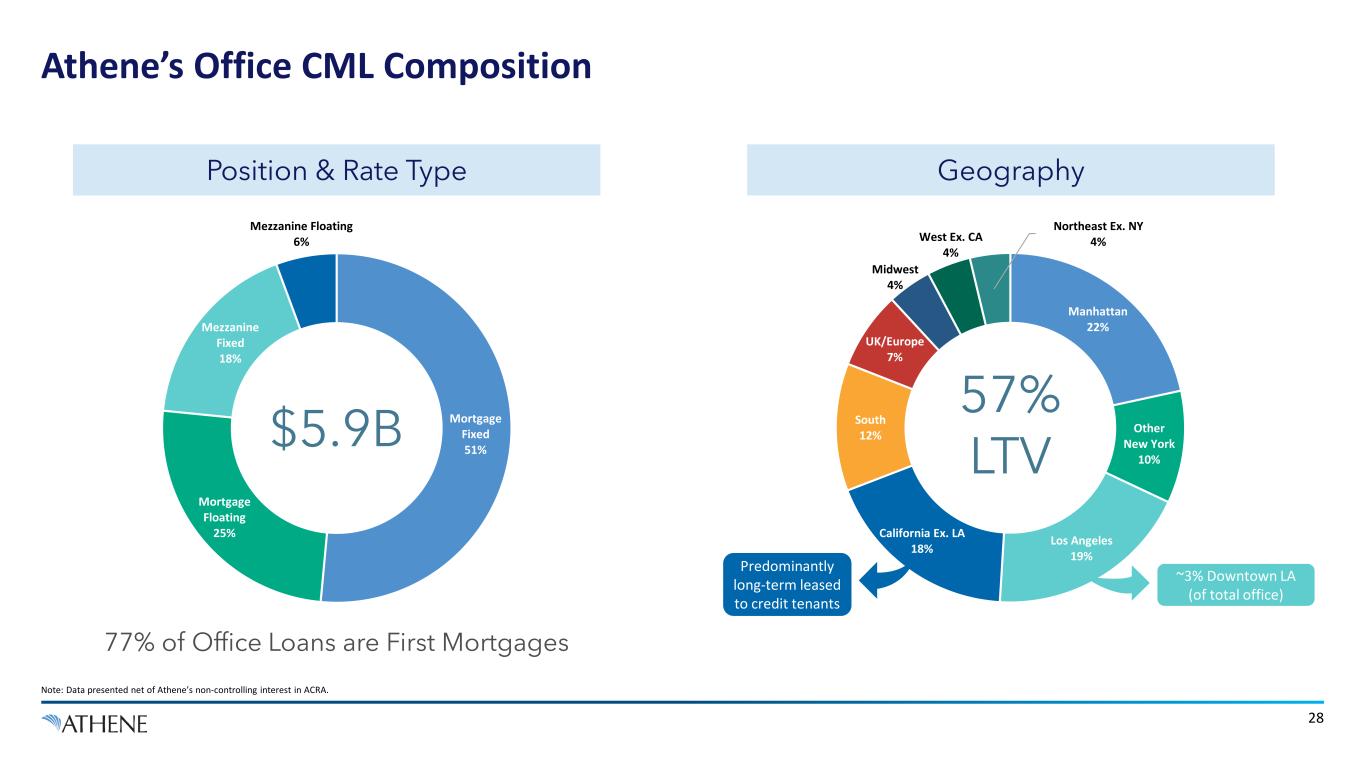
Manhattan 22% Other New York 10% Los Angeles 19% California Ex. LA 18% South 12% UK/Europe 7% Midwest 4% West Ex. CA 4% Northeast Ex. NY 4% Athene’s Office CML Composition Note: Data presented net of Athene’s non-controlling interest in ACRA. 28 57% LTV Predominantly long-term leased to credit tenants ~3% Downtown LA (of total office) Mortgage Fixed 51% Mortgage Floating 25% Mezzanine Fixed 18% Mezzanine Floating 6% 77% of Office Loans are First Mortgages $5.9B Position & Rate Type Geography
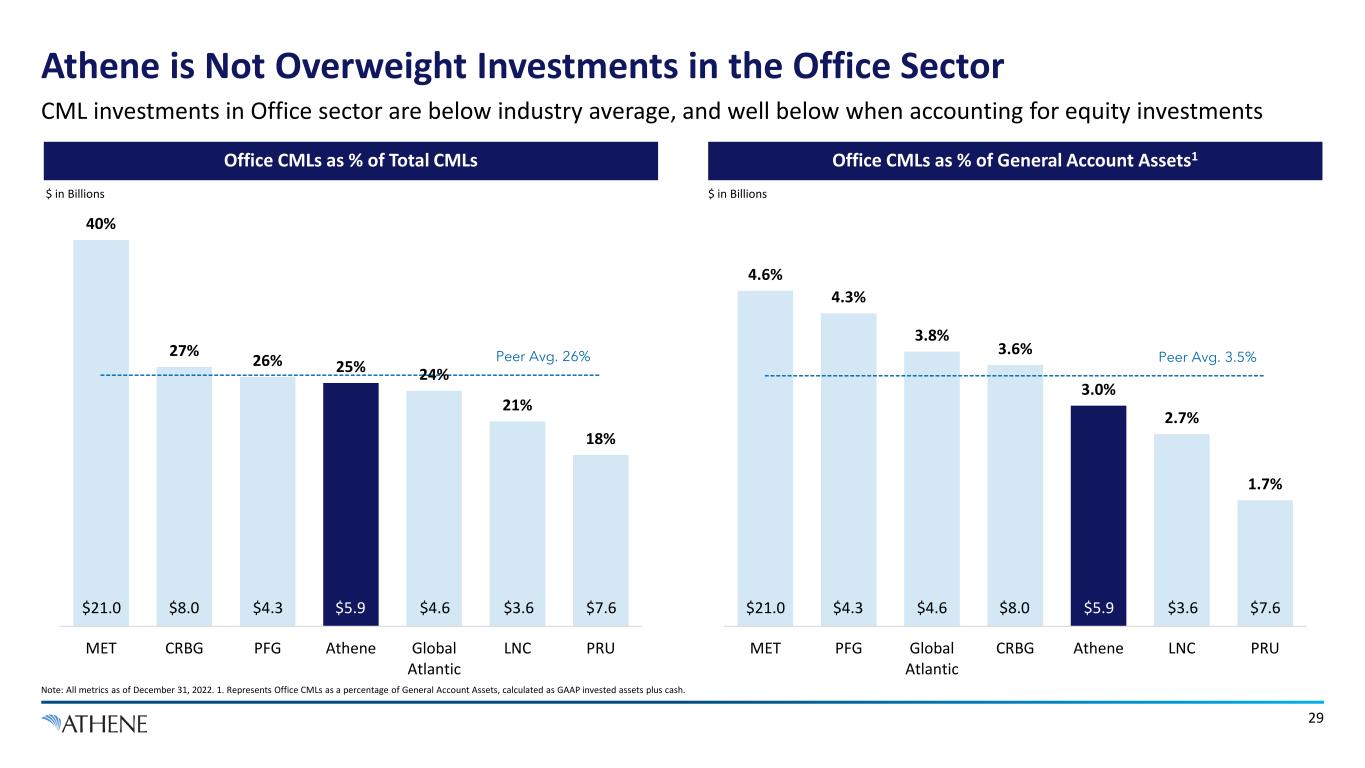
Athene is Not Overweight Investments in the Office Sector Note: All metrics as of December 31, 2022. 1. Represents Office CMLs as a percentage of General Account Assets, calculated as GAAP invested assets plus cash. 29 4.6% 4.3% 3.8% 3.6% 3.0% 2.7% 1.7% Peer Avg. 3.5% MET PFG Global Atlantic CRBG Athene LNC PRU 40% 27% 26% 25% 24% 21% 18% Peer Avg. 26% MET CRBG PFG Athene Global Atlantic LNC PRU Office CMLs as % of Total CMLs Office CMLs as % of General Account Assets1 CML investments in Office sector are below industry average, and well below when accounting for equity investments $21.0 $8.0 $4.3 $5.9 $4.6 $3.6 $7.6 $ in Billions $21.0 $4.3 $4.6 $8.0 $5.9 $3.6 $7.6 $ in Billions
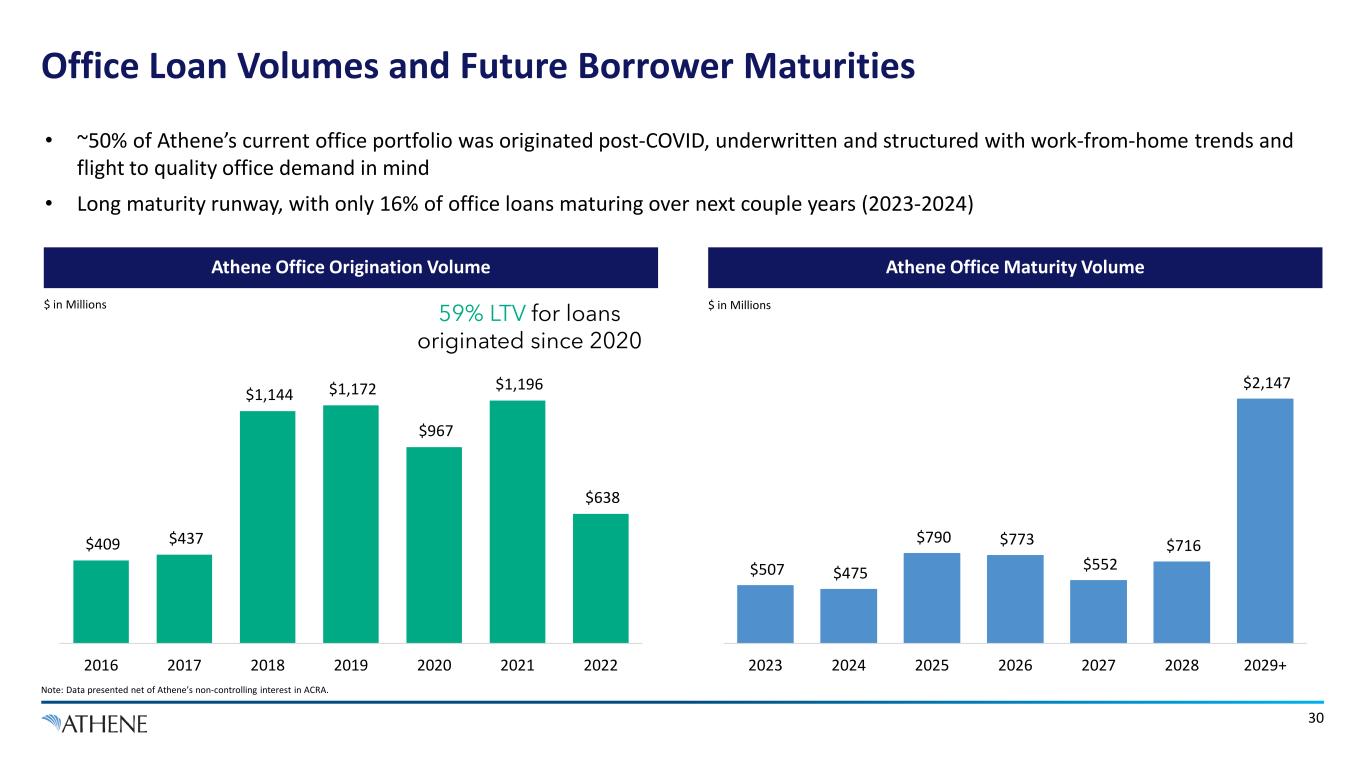
Office Loan Volumes and Future Borrower Maturities Note: Data presented net of Athene’s non-controlling interest in ACRA. 30 • ~50% of Athene’s current office portfolio was originated post-COVID, underwritten and structured with work-from-home trends and flight to quality office demand in mind • Long maturity runway, with only 16% of office loans maturing over next couple years (2023-2024) $ in Millions $ in Millions59% LTV for loans originated since 2020 $409 $437 $1,144 $1,172 $967 $1,196 $638 2016 2017 2018 2019 2020 2021 2022 $507 $475 $790 $773 $552 $716 $2,147 2023 2024 2025 2026 2027 2028 2029+ Athene Office Maturity VolumeAthene Office Origination Volume
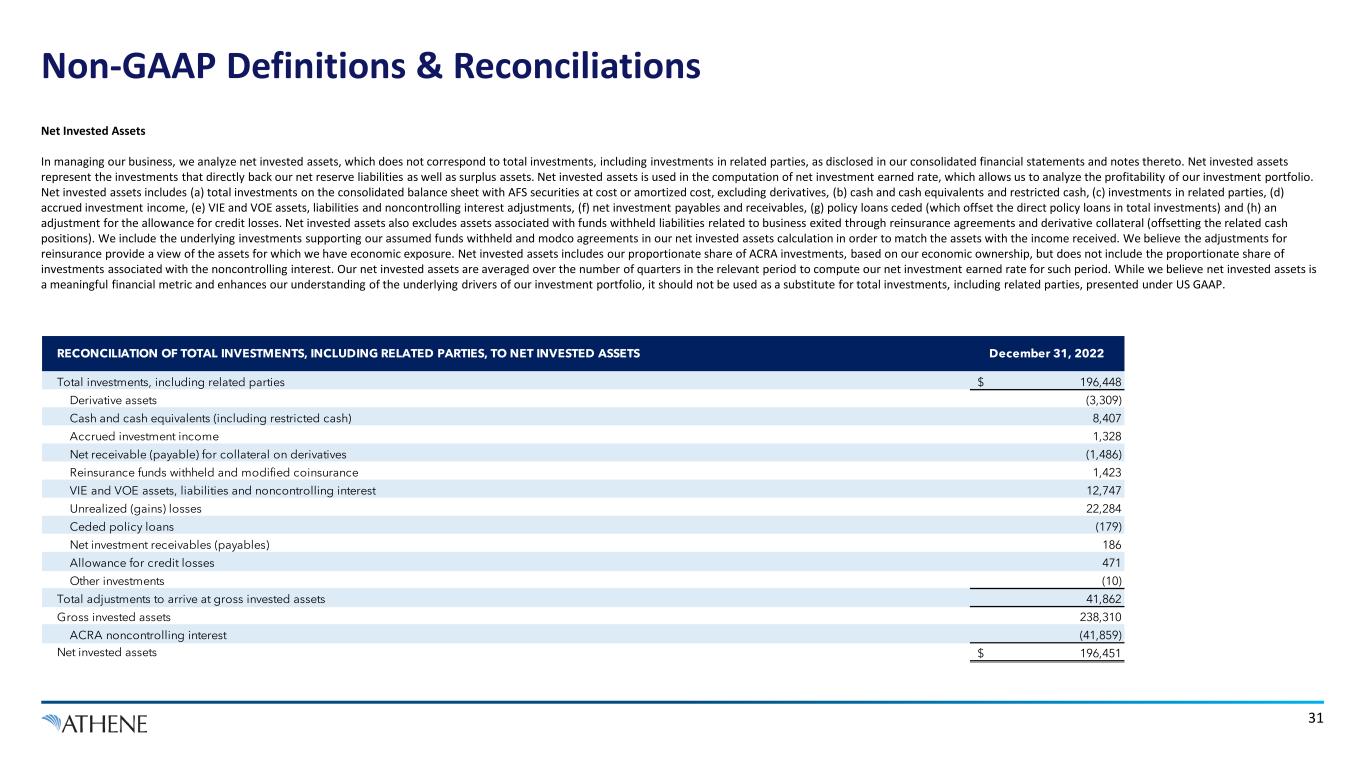
Non-GAAP Definitions & Reconciliations 31 Net Invested Assets In managing our business, we analyze net invested assets, which does not correspond to total investments, including investments in related parties, as disclosed in our consolidated financial statements and notes thereto. Net invested assets represent the investments that directly back our net reserve liabilities as well as surplus assets. Net invested assets is used in the computation of net investment earned rate, which allows us to analyze the profitability of our investment portfolio. Net invested assets includes (a) total investments on the consolidated balance sheet with AFS securities at cost or amortized cost, excluding derivatives, (b) cash and cash equivalents and restricted cash, (c) investments in related parties, (d) accrued investment income, (e) VIE and VOE assets, liabilities and noncontrolling interest adjustments, (f) net investment payables and receivables, (g) policy loans ceded (which offset the direct policy loans in total investments) and (h) an adjustment for the allowance for credit losses. Net invested assets also excludes assets associated with funds withheld liabilities related to business exited through reinsurance agreements and derivative collateral (offsetting the related cash positions). We include the underlying investments supporting our assumed funds withheld and modco agreements in our net invested assets calculation in order to match the assets with the income received. We believe the adjustments for reinsurance provide a view of the assets for which we have economic exposure. Net invested assets includes our proportionate share of ACRA investments, based on our economic ownership, but does not include the proportionate share of investments associated with the noncontrolling interest. Our net invested assets are averaged over the number of quarters in the relevant period to compute our net investment earned rate for such period. While we believe net invested assets is a meaningful financial metric and enhances our understanding of the underlying drivers of our investment portfolio, it should not be used as a substitute for total investments, including related parties, presented under US GAAP. Total investments, including related parties Derivative assets Cash and cash equivalents (including restricted cash) Accrued investment income Net receivable (payable) for collateral on derivatives Reinsurance funds withheld and modified coinsurance VIE and VOE assets, liabilities and noncontrolling interest Unrealized (gains) losses Ceded policy loans Net investment receivables (payables) Allowance for credit losses Other investments Total adjustments to arrive at gross invested assets Gross invested assets ACRA noncontrolling interest Net invested assets RECONCILIATION OF TOTAL INVESTMENTS, INCLUDING RELATED PARTIES, TO NET INVESTED ASSETS December 31, 2022 (1,486) 1,423 8,407 1,328 $ 196,448 (3,309) 471 41,862 (179) 186 12,747 22,284 $ 196,451 (10) 238,310 (41,859)






























